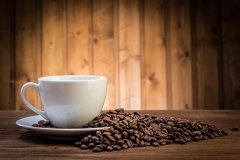Drip method | demonstration of hand-made coffee with kono filter cup

、
For professional baristas, please follow the coffee workshop (Wechat official account cafe_style)
15 grams of deep-baked manning
KALITA copper pot
KONO 01 filter cup
Steaming time 2: 47 seconds
'To
Mr. Kono, the president who designed coffee filter cups and coffee pots, has studied delicious coffee for many years, and has designed a series of coffee pots full of pastoral KONO coffee filter cups and log handles. KONO is not only the favorite professional coffee utensils used by coffee shops and coffee professionals in Japan, but also the product pursued by many lovers who like drip coffee.
As we all know, the rate of falling water level will affect the time that coffee powder particles are soaked in water, so the fan-shaped filter cup is to improve this factor by deepening the depth of the ribs, that is, increasing the exhaust effect, which is one way; another way is to change the shape of the filter cup to increase the concentration of water, so the conical filter cup arises at the historic moment.
A closer look at the ribs of the KONO filter cup shows that the ribs of the KONO do not extend from the bottom to the top, but stop when they are less than half the height of the filter cup. This height is designed to ensure that during the dripping process, the filter paper can be attached to the wall of the filter cup after absorbing water, and once the exhaust space is limited, the air flow will be limited, which will increase the water absorption time of coffee powder particles.
For coffee powder, water droplets are the best amount of water to absorb, because when the water droplets continue to drop on the powder layer, they do not spread immediately, and because the amount of water droplets is small, it is easier for coffee powder particles to absorb water, so for tapered filter cups with deeper powder layers, water droplet boiling is an excellent way to feed water.
Although the tapered filter cup can concentrate the amount of powder, the rapid decline of the water level is not the demand at the beginning of brewing, because before the coffee powder particles reach the target water absorption, it is more desirable that the water droplets dropped by the hand flushing pot can stay in the powder layer as long as possible. this requirement can be carried out in a way of reducing exhaust volume, that is, after absorbing water, the filter paper is affixed to the wall of the filter cup to reduce the space for air flow. The neatly arranged ribs at the bottom of the KONO are the key to the above demands in subsequent extraction.
The drip water injection method is called the essence extraction method because the coffee is extracted with high concentration in the front stage.
In the process of dripping, the coffee powder particle layer on the surface will slowly rise, which is the same as the coffee powder exhaust and push before, when the powder layer expands continuously, the coffee powder particles will absorb more water, and when it reaches saturation, the water will slowly accumulate at the bottom, and when it accumulates to a certain extent, the air will be squeezed, and a small extraction water column will be produced, resulting in pneumatic extraction.
Therefore, when using the KONO filter cup, when using the drop method to produce a small water column, in order to maintain the pneumatic extraction, it is necessary to feed the water until the water level reaches a little more water above the ribs, so that the filter paper can be closely attached to the wall of the filter cup, preventing the air from flowing upward, creating a relatively airtight space, because the upward passage is blocked, and the water can only flow in the direction of the filter paper and the ribs. The internal water will continue to be pushed down until the pneumatic extraction water column is produced and continues until the water flows out, so the key to using the KONO filter cup is to keep the feed water above the ribs in order to produce the pneumatic extraction of KONO.
It is called the dripping method because the water flow is weak, damaging the coffee powder layer as little as possible, reducing convection, increasing the soaking time, and injecting water into the hand pot in a drop-by-drop state. It is suitable to use the flattened wide mouth spout and the wide mouth crane spout. The advantage is that the flow of the large water column is flexible, and the thickness of the flow is more controllable, which is suitable for the drip method.
Experiment: the principle of spot-by-drop hand flushing for segmented extraction testing
Coffee beans: Yega snow caffeine (medium and shallow roast)
Water temperature: 88 degrees
Grinding: rough grinding (sugar size)
Method: hand flushing
After rough grinding, 20g coffee beans are grinded with the ratio of powder to water at 1:12, using water droplets, fine water flow and coarse water flow, and it takes 4 to 5 minutes to produce a cup of 240cc coffee.
The first test: did not take a picture, drew a picture to show
Cup test results: the first two cups are sweet, sour and sweet, with fermented aromas; the last two cups are floral and citrus, with distinct layers. After testing, the first feeling is that the moderate baking products will be easy to melt in water, while the shallow baking products are relatively difficult to melt in water.
The second test: to test the effect of low water-powder ratio and lengthening extraction time on segmentation.
Operation: fill it with water just enough to fill a cup, cut off the water, then rest for 60 seconds, then to the next cup, and so on until the fourth cup is finished. That is, each cup contains water filling and steaming for 60 seconds.
Cup test results: 4 cups are sweet, sweet and sour, fermented aroma, cups 1 and 2 are the strongest, cups 3 and 4 are slightly weaker. The aroma of flowers and fruits is only a little in Cup 4.
This result is very surprised, the last two cups in the first test no longer have the taste of the first two cups, but they appear again in the second test, and the aroma of flowers and fruits is gone.
If there is no problem, it can be summed up like this:
Factors affecting extraction: medium baking products-longer extraction time, shallow baking products-increasing the ratio of water to powder (the more water, the lower the concentration, the easier it is for low molecular weight substances in coffee)
The third test: the operation method is the same as the second test, the difference is that the large flow begins in cup 3 to increase the amount of water in the filter cup.
Cup test results: sure enough, as expected, Cup 4 showed a bright aroma of flowers and fruits.
It suddenly reminds me of the Japanese hand-punching method. Keep dripping on the dry powder for a long time and then quickly end with a large flow of water. It may be to use a long time drip to extract the aroma of the back part of the baking as much as possible while not producing the miscellaneous smell in the environment with low water powder ratio, and then extract the flower and fruit fragrance of the front part with a high water powder ratio. (source: @ Coffee Man Lu Xiansen's blog)
Hand punching pot suitable for kono drip method
[flattened wide mouth spout], the advantage is that the flow of the large water column is soft, and the thickness of the water flow is more controllable, but it is not easy to control the fine water column, and if the inclination is not well controlled, it is easy to make the water flow out.
[crane mouth enamel hand punch] Kalita this crane mouth enamel hand punch, long flat spout (crane mouth) special design, shaped like a crane mouth, it is easy to control the thickness of the water. The capacity is exactly one liter, the flow of water is smooth, and the size of the water column is easily controlled, so it is very easy to use to flush the pot by hand.
YUKIWA has the largest number of stainless steel hand punching styles, and the M5 for Taguchi protection and the narrow and wide versions of KONO shown below can be used for KONO (Kono) hand flushing.
Disclaimer: compiled and edited by "Coffee Workshop", this article is original, reproduced, please indicate that this article is intended to spread coffee culture, if infringement, please inform delete, thank you!
For more professional coffee exchanges, please scan the code and follow Wechat: IMAKECOFFEE
Important Notice :
前街咖啡 FrontStreet Coffee has moved to new addredd:
FrontStreet Coffee Address: 315,Donghua East Road,GuangZhou
Tel:020 38364473
- Prev

Thai iced coffee | if you make a cold cup of Thai Gufa iced coffee
For professional baristas, please follow the coffee workshop (Wechat official account cafe_style) very strong coffee mixed with ice cubes, and then add cardamom, a spice native to the East Indies, with cream and sugar, so a cup of Thai iced coffee takes you to Phuket under the scorching sun and sea breeze in an instant. If there is a kind of coffee that can bring you a cool sea on a hot summer day
- Next

cup test| How to perform the cup test, the terminology used for the cup test
Professional barista communication, please pay attention to Coffee Workshop (Weixin Official Accounts cafe_style ) Coffee Cupping, Chinese translation coffee cup test, is a very magical and simple coffee sensory evaluation method. The quality of coffee is judged by taste, which is called coffee cup test. Make sure the coffee flows back and forth in your mouth, making full use of your taste and smell to feel the coffee.
Related
- Beginners will see the "Coffee pull flower" guide!
- What is the difference between ice blog purified milk and ordinary milk coffee?
- Why is the Philippines the largest producer of crops in Liberia?
- For coffee extraction, should the fine powder be retained?
- How does extracted espresso fill pressed powder? How much strength does it take to press the powder?
- How to make jasmine cold extract coffee? Is the jasmine + latte good?
- Will this little toy really make the coffee taste better? How does Lily Drip affect coffee extraction?
- Will the action of slapping the filter cup also affect coffee extraction?
- What's the difference between powder-to-water ratio and powder-to-liquid ratio?
- What is the Ethiopian local species? What does it have to do with Heirloom native species?

